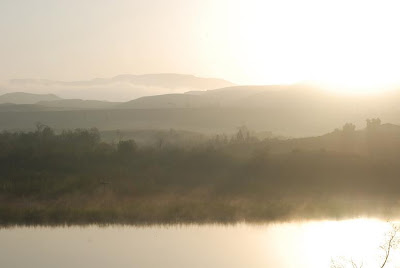
One of the primary reasons my family moved to this particular corner of Orange was its proximity to three large parks: Santiago Oaks, Irvine, and Peters Canyon Regional Parks. All are within two miles of my house, so it's easy for me to ride my bike to any of them for a couple hours before or after school. They're decent birding spots--they don't attract the number of rarities coastal places like Huntington Central Park do, but there's always something interesting to see. The first few weeks after I moved were exciting, to say the least...Wrentits! California Thrashers! Spotted Towhees! California Gnatcatchers!
Though these parks have lost their initial mysteriousness and wonder, I still enjoy birding them. Sadly, I've been neglecting the trio this winter, particularly Peters Canyon. Early Friday, I woke well before sunrise for a long-overdue hike at Peters Canyon.

If you have the choice, start your hikes before sunrise. The moments when it is not quite light--sparkling dew clinging to the grass, gray mist rolling through the valleys, the sky glowing pink and yellow--are magical.

Wildflowers offered another incentive to pry myself out of bed early Friday morning. With the warmer temperatures we've been having the last couple weeks, wildflowers are going crazy! (Note to local readers: if you get the chance, drive down the 261 toll road. The number of lupines are phenomenal!)

Sticky Monkeyflower (Mimulus aurantiacus)

California Goldfields (Lasthenia california)

Cleveland's Cryptantha (Cryptantha clevelandii)

California Encelia (Encelia californica)

Parry's Phacelia (Phacelia parryi)

Oh yeah, birds! Mid-March is a fun time of year to bird Southern California. Some of the wintering birds (e.g., ducks) are thinning out, though an interesting mix of winter species remain and early migrants are coming through. I saw relatively few land bird migrants--some Bullock's and Hooded Orioles, three Wilson's Warblers, and swallows, though the latter have been coming through since January. And, of course, the local residents are around, most of them singing. Everywhere you look, you see courtship displays, nest building, even a few adult birds carrying food. Cassin's Kingbirds are always around (the seasonal movements of this species are interesting, since it isn't sedentary--at least some of the wintering birds are different from the local breeders), but always fun to see.

Audubon's Warblers are ubiquitous winter residents in Orange County, to the point that a hike with none detected is almost a pleasure. I like them, though. If you're bored in the winter, there will ALWAYS be a butterbutt to look at. Many of the males--experiencing prealternate molt--are looking spiffy. Apparently their hormones are beginning to really kick in, too, since they've suddenly started singing in the last week or so.
From a purely technical standpoint, it was a boring hike--no Yellow-billed Loons, Bar-tailed Godwits, or Painted Redstarts. In fact, the most unusual bird was a Western Gull--the first I've had at the park. Good thing I'm not looking at it from a technical standpoint. I love hearing the Common Yellowthroat's whitchity-whichity-whichity-which, seeing my first migrant Wilson's Warblers of the year, and watching a male House Finch singing his heart out and courtship-feeding a female. It's part of the magic of birding.
No comments:
Post a Comment